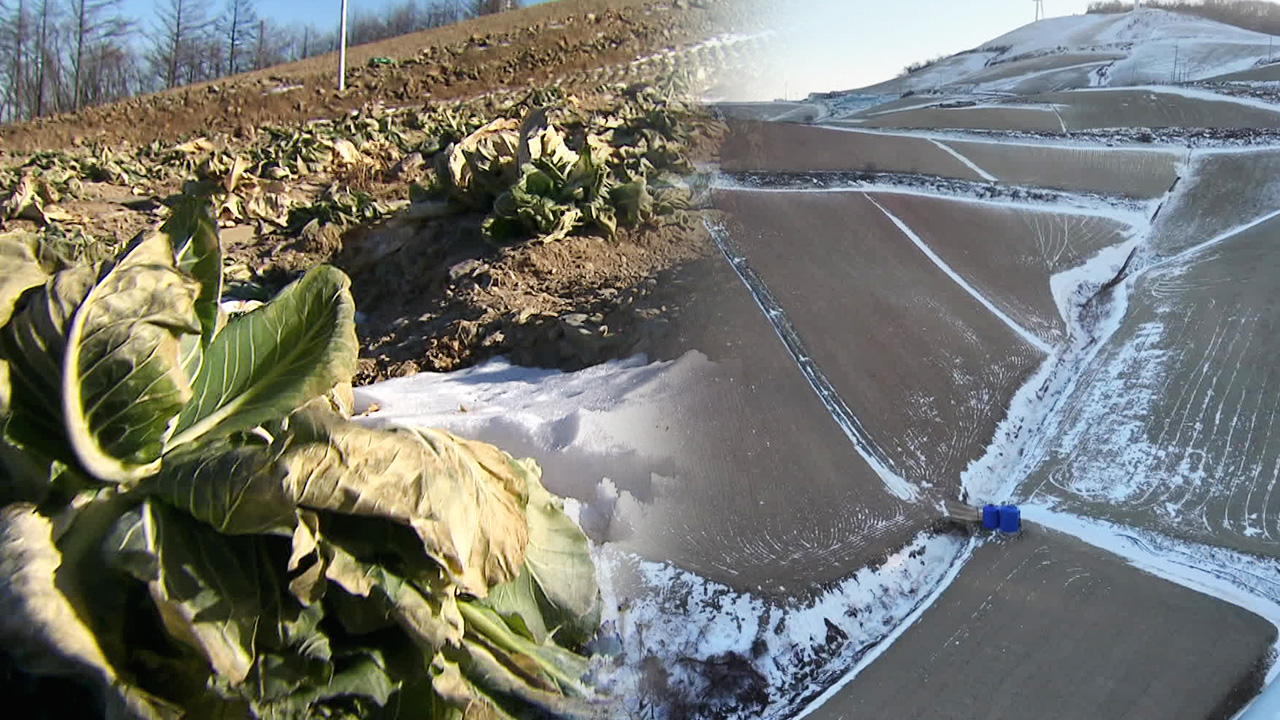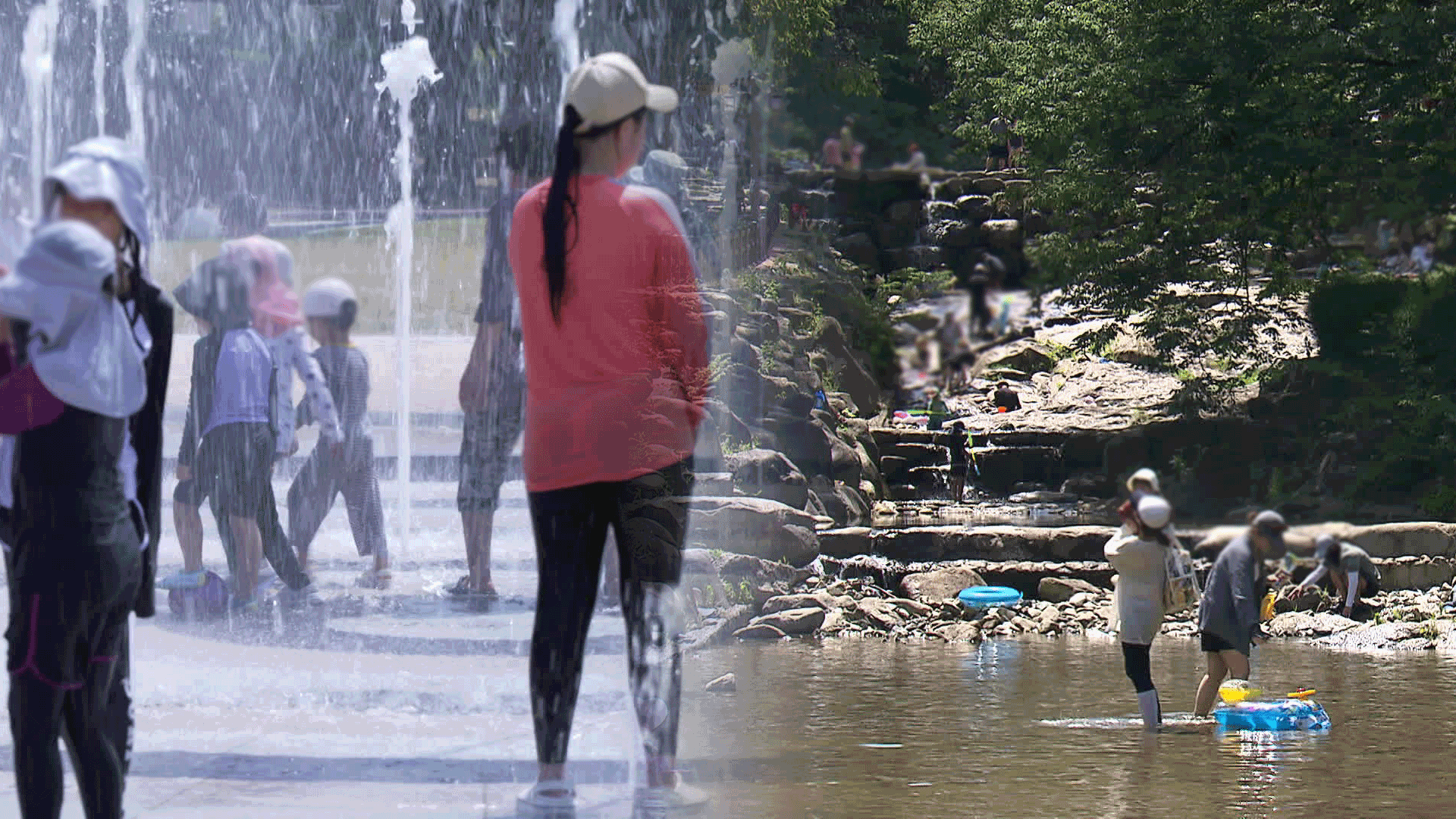Climate crisis changes agricultural landscape
입력 2025.01.13 (00:49)
읽어주기 기능은 크롬기반의
브라우저에서만 사용하실 수 있습니다.
[Anchor]
This is a continuous report examining the climate crisis.
Climate change is also altering the agricultural landscape of the Korean Peninsula.
Our farmers are facing many difficulties.
To understand how serious the situation is, meteorologist Lee Se-heum visited a highland cabbage field in Gangwon Province.
[Report]
Taebaek City in Gangwon Province, with an average elevation of 900 meters.
Thanks to its cool climate even in summer, it is a major production area for highland cabbage.
However, unharvested cabbages are still abundant in the fields from last year's harvest season.
Due to the unusually long and intense heatwave last year, the cabbages did not grow properly, leading to a decision to abandon the harvest.
[Yoon In-kyu/Taebaek: "We keep incurring losses, so cabbage farming has only managed to produce about 30% compared to previous years."]
Last summer, there were 27 days when the average daily temperature in Taebaek City exceeded 25 degrees, a significant increase compared to the last five years.
[Lee Young-kyu/Highland Agriculture Research Institute Cabbage Research Director: "Cabbage is a cool-season crop, so temperatures above 26 degrees affect its growth."]
The rising temperatures have also brought about new pests and diseases.
This is because the microbial community in the soil is changing.
[Lee Young-kyu/Highland Agriculture Research Institute Cabbage Research Director: "In the past, there were many occurrences of cabbage root maggot disease, but now, as temperatures rise, there are increasing incidences of wilt disease caused by Verticillium, which thrives at soil temperatures of 24-25 degrees..."]
Climate change is altering the main agricultural production areas in our country.
In the last 20 years, the area for highland cabbage cultivation in Gangwon Province has halved.
If this continues, by 2070, the cabbage fields on Maebongsan Mountain are expected to be replaced by apple or tangerine orchards.
The accelerating pace of climate change is also a problem, as there is insufficient time to respond.
[Jo Jeong-rae/Gangneung: "The climate has become one of high temperatures and heavy rains. In the last 2-3 years, or 3-4 years..."]
The significant reduction in the supply of certain crops, such as cabbage, is leading to price increases, putting pressure on food costs.
This is KBS News, Lee Se-heum.
This is a continuous report examining the climate crisis.
Climate change is also altering the agricultural landscape of the Korean Peninsula.
Our farmers are facing many difficulties.
To understand how serious the situation is, meteorologist Lee Se-heum visited a highland cabbage field in Gangwon Province.
[Report]
Taebaek City in Gangwon Province, with an average elevation of 900 meters.
Thanks to its cool climate even in summer, it is a major production area for highland cabbage.
However, unharvested cabbages are still abundant in the fields from last year's harvest season.
Due to the unusually long and intense heatwave last year, the cabbages did not grow properly, leading to a decision to abandon the harvest.
[Yoon In-kyu/Taebaek: "We keep incurring losses, so cabbage farming has only managed to produce about 30% compared to previous years."]
Last summer, there were 27 days when the average daily temperature in Taebaek City exceeded 25 degrees, a significant increase compared to the last five years.
[Lee Young-kyu/Highland Agriculture Research Institute Cabbage Research Director: "Cabbage is a cool-season crop, so temperatures above 26 degrees affect its growth."]
The rising temperatures have also brought about new pests and diseases.
This is because the microbial community in the soil is changing.
[Lee Young-kyu/Highland Agriculture Research Institute Cabbage Research Director: "In the past, there were many occurrences of cabbage root maggot disease, but now, as temperatures rise, there are increasing incidences of wilt disease caused by Verticillium, which thrives at soil temperatures of 24-25 degrees..."]
Climate change is altering the main agricultural production areas in our country.
In the last 20 years, the area for highland cabbage cultivation in Gangwon Province has halved.
If this continues, by 2070, the cabbage fields on Maebongsan Mountain are expected to be replaced by apple or tangerine orchards.
The accelerating pace of climate change is also a problem, as there is insufficient time to respond.
[Jo Jeong-rae/Gangneung: "The climate has become one of high temperatures and heavy rains. In the last 2-3 years, or 3-4 years..."]
The significant reduction in the supply of certain crops, such as cabbage, is leading to price increases, putting pressure on food costs.
This is KBS News, Lee Se-heum.
■ 제보하기
▷ 카카오톡 : 'KBS제보' 검색, 채널 추가
▷ 전화 : 02-781-1234, 4444
▷ 이메일 : kbs1234@kbs.co.kr
▷ 유튜브, 네이버, 카카오에서도 KBS뉴스를 구독해주세요!
- Climate crisis changes agricultural landscape
-
- 입력 2025-01-13 00:49:17

[Anchor]
This is a continuous report examining the climate crisis.
Climate change is also altering the agricultural landscape of the Korean Peninsula.
Our farmers are facing many difficulties.
To understand how serious the situation is, meteorologist Lee Se-heum visited a highland cabbage field in Gangwon Province.
[Report]
Taebaek City in Gangwon Province, with an average elevation of 900 meters.
Thanks to its cool climate even in summer, it is a major production area for highland cabbage.
However, unharvested cabbages are still abundant in the fields from last year's harvest season.
Due to the unusually long and intense heatwave last year, the cabbages did not grow properly, leading to a decision to abandon the harvest.
[Yoon In-kyu/Taebaek: "We keep incurring losses, so cabbage farming has only managed to produce about 30% compared to previous years."]
Last summer, there were 27 days when the average daily temperature in Taebaek City exceeded 25 degrees, a significant increase compared to the last five years.
[Lee Young-kyu/Highland Agriculture Research Institute Cabbage Research Director: "Cabbage is a cool-season crop, so temperatures above 26 degrees affect its growth."]
The rising temperatures have also brought about new pests and diseases.
This is because the microbial community in the soil is changing.
[Lee Young-kyu/Highland Agriculture Research Institute Cabbage Research Director: "In the past, there were many occurrences of cabbage root maggot disease, but now, as temperatures rise, there are increasing incidences of wilt disease caused by Verticillium, which thrives at soil temperatures of 24-25 degrees..."]
Climate change is altering the main agricultural production areas in our country.
In the last 20 years, the area for highland cabbage cultivation in Gangwon Province has halved.
If this continues, by 2070, the cabbage fields on Maebongsan Mountain are expected to be replaced by apple or tangerine orchards.
The accelerating pace of climate change is also a problem, as there is insufficient time to respond.
[Jo Jeong-rae/Gangneung: "The climate has become one of high temperatures and heavy rains. In the last 2-3 years, or 3-4 years..."]
The significant reduction in the supply of certain crops, such as cabbage, is leading to price increases, putting pressure on food costs.
This is KBS News, Lee Se-heum.
This is a continuous report examining the climate crisis.
Climate change is also altering the agricultural landscape of the Korean Peninsula.
Our farmers are facing many difficulties.
To understand how serious the situation is, meteorologist Lee Se-heum visited a highland cabbage field in Gangwon Province.
[Report]
Taebaek City in Gangwon Province, with an average elevation of 900 meters.
Thanks to its cool climate even in summer, it is a major production area for highland cabbage.
However, unharvested cabbages are still abundant in the fields from last year's harvest season.
Due to the unusually long and intense heatwave last year, the cabbages did not grow properly, leading to a decision to abandon the harvest.
[Yoon In-kyu/Taebaek: "We keep incurring losses, so cabbage farming has only managed to produce about 30% compared to previous years."]
Last summer, there were 27 days when the average daily temperature in Taebaek City exceeded 25 degrees, a significant increase compared to the last five years.
[Lee Young-kyu/Highland Agriculture Research Institute Cabbage Research Director: "Cabbage is a cool-season crop, so temperatures above 26 degrees affect its growth."]
The rising temperatures have also brought about new pests and diseases.
This is because the microbial community in the soil is changing.
[Lee Young-kyu/Highland Agriculture Research Institute Cabbage Research Director: "In the past, there were many occurrences of cabbage root maggot disease, but now, as temperatures rise, there are increasing incidences of wilt disease caused by Verticillium, which thrives at soil temperatures of 24-25 degrees..."]
Climate change is altering the main agricultural production areas in our country.
In the last 20 years, the area for highland cabbage cultivation in Gangwon Province has halved.
If this continues, by 2070, the cabbage fields on Maebongsan Mountain are expected to be replaced by apple or tangerine orchards.
The accelerating pace of climate change is also a problem, as there is insufficient time to respond.
[Jo Jeong-rae/Gangneung: "The climate has become one of high temperatures and heavy rains. In the last 2-3 years, or 3-4 years..."]
The significant reduction in the supply of certain crops, such as cabbage, is leading to price increases, putting pressure on food costs.
This is KBS News, Lee Se-heum.
-
-

이세흠 기자 hmm@kbs.co.kr
이세흠 기자의 기사 모음
-
이 기사가 좋으셨다면
-
좋아요
0
-
응원해요
0
-
후속 원해요
0















이 기사에 대한 의견을 남겨주세요.